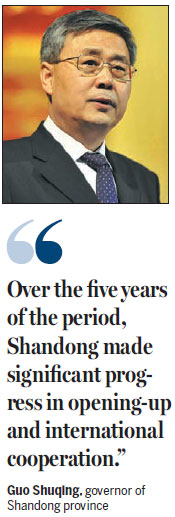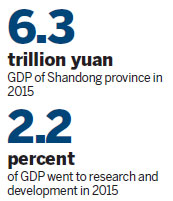Shandong reports major growth across economy
Despite the complicated economic environment, East China's Shandong province reported strong economic growth in the 12th Five-Year Plan period (2011-15).
"Over the five years of the period, Shandong has had outstanding achievements in economic growth, people's livelihoods, innovation and opening-up," Guo Shuqing, governor of the province, said during the ongoing National People's Congress and the Chinese People's Political Consultative Conference meetings.
Shandong's GDP reached 6.3 trillion yuan ($962 billion) last year, ranking it among China's three largest economies. The average annual growth rate over the five years was 9.4 percent.

Guo said the provincial government is doing its best to improve the livelihoods of residents.
The government helped 6.65 million rural workers find jobs in cities and offered 5.94 million new vacancies to urban residents. The per capita disposable income of its urban residents has risen by an annual average growth rate of 8 percent while the net income of rural residents has grown by 10.1 percent.
Shandong currently has 13 national high-tech industrial zones, 1,427 provincial-level or above company-owned technology centers and 35 engineering research centers. Expenditure on research and development accounted for more than 2.2 percent of Shandong's GDP in 2015, up from more than 1.7 percent in 2011.
"During the past five years, Shandong made significant progress in opening-up and international cooperation," said Guo.
According to statistics from the Shandong provincial department of commerce, China built 13 State-level overseas economic and trade cooperation zones by the end of the year, three of which are backed by Shandong. They are the Sino-Russian Industry and Trade Cooperation zone, the Haier-Yoruba Economic Park in Pakistan and the Central European Trade and Logistics Cooperation Zone in Hungary.
Shandong's volume of exports and imports combined was valued at $241.75 billion last year, up 27.8 percent over 2010.
More than 6,800 foreign-invested projects were launched in Shandong in the past five years. The province's total used foreign capital was $69.1 billion, about 1.5 times more than the previous five years.
Shandong has also attracted 149 Fortune Global 500 companies to establish branches in the province.
One example is the $2-billion IT industry base and software talent training center invested by US IT giant Hewlett-Packard in Jining. Following HP's step, about 150 leading IT companies such as Oracle, IBM and Siemens also decided to invest in the city. "The provincial government introduced a variety of measures to attract overseas investors during the past five years. A series of investment promotion activities were held annually in China's Hong Kong and Taiwan as well as South Korea and Japan," said Wang Hua, chief of the provincial department of commerce.
Shandong has held the annual trade and investment promotion meeting in Hong Kong for seven years, which has become an important platform to showcase Shandong's resources and industrial advantages to Hong Kong investors.

Shandong's total use of Hong Kong investment jumped to $7.55 billion in 2015 from $4.33 billion in 2010. It accounted for nearly half of the province's overseas investment. Hong Kong has been the largest source of overseas investment in the province for seven consecutive years.
"Shandong is looking for a pioneer role on the international stage by seizing the opportunities associated with the Belt and Road Initiative and China's free trade agreements with South Korea and Australia," said Guo.
The Chinese government's action plan on building the Silk Road Economic Belt and the 21st Century Maritime Silk Road released last year listed Shandong's two coastal cities, Yantai and Qingdao, among 15 key Chinese cities along the Belt and Road.
Last year Shandong signed $6.14 billion in contracts with countries along the Belt and Road, according to the provincial department of commerce.
Taking advantage of the free trade agreements, Shandong will speed up the construction of regional economic cooperation demonstration zones of China-South Korea trade and investment in Weihai and Yantai. The province also plans to apply for developing a pilot free trade zone, according to Guo.
wangqian2@chinadaily.com.cn
(China Daily 03/09/2016 page10)








